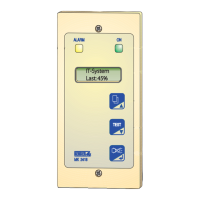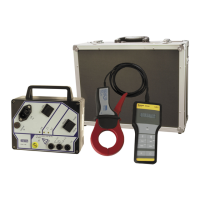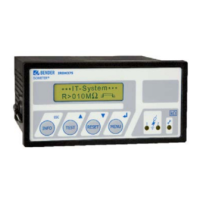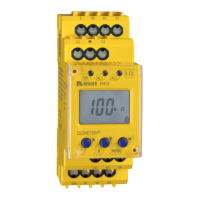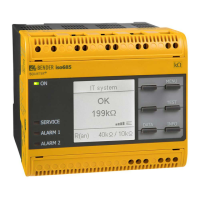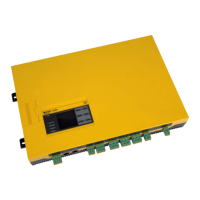Installation and connection
28
MK2430_D00129_02_M_XXEN/09.2019
Legend to wiring diagram
* Devices without BMS bus connection, but with test input (e.g. ISOMETER®)
Make sure that the MK2430 power supply is isolated from PE. If this is not
taken into consideration and if a PC is connected to the USB interface, the
MK 2430 device and the PC may be damaged.
1
Terminating resistor:
If two or more devices are connected to each other via the BMS bus, the bus
line must be terminated at both ends with a resistor (R = 120 Ω). (The resistors
can be activated via DIP switch on the MK2430 and alarm indicator and opera-
tor panel).
2
BMS bus connection:
Various Bender devices with a BMS bus interface, such as insulation monitoring
devices isoMED427P, 107TD47, control devices PRC487, residual current moni-
tors RCMS470, can be connected to the BMS bus.
3
Power supply unit in the MEDICS® module, sufficient for supplying power to at
least three MK2430.
4
Cable between the MEDICS® module and the MK2430. Please observe the per-
missible cable lengths and cross sections when using the AN450 power supply
unit in MEDICS® modules.
5
Digital inputs. The digital inputs may be activated either via internal or external
voltage or potential-free contacts. If the inputs are controlled via an external
voltage, the common 0(-) is applied to terminal "0" and the 1(+) signal to the
relevant input IN1 … IN12. In this case, the connections between terminals 0
and V2, and the common connections and U2 are not required.
6
USB interface. For PC connection. The TMK-SET PC software is used to program
the MK2430. You can use the PC software TMK-HISTORY to read out the
MK2430 history memory.
7
MK2430-11 only: Relay output. Programmable contact for device errors, test of
assigned devices*, device failure and common alarm message.

